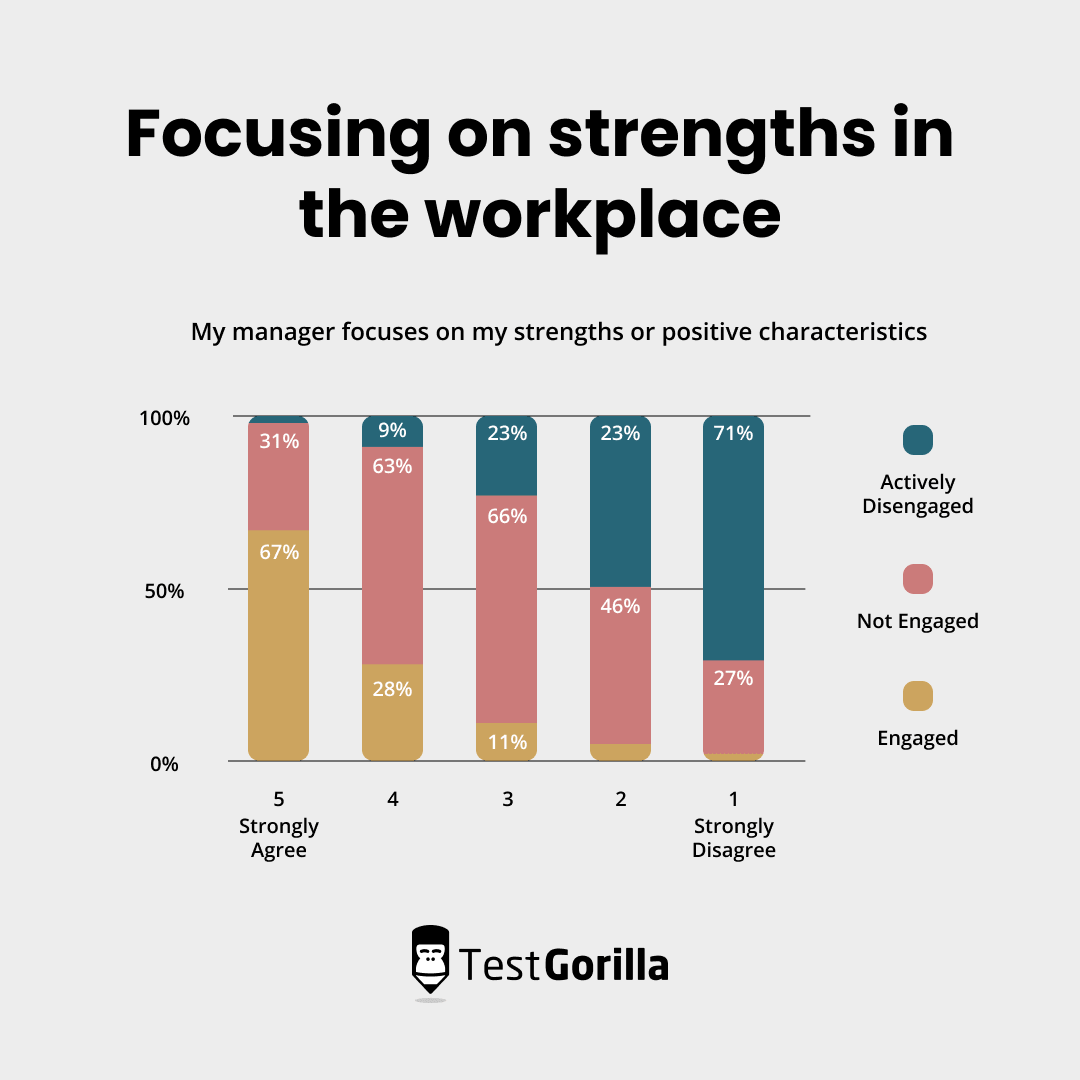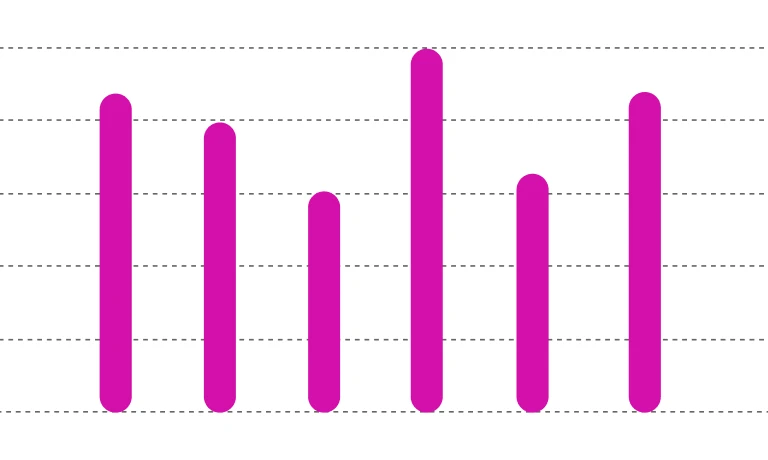How to use the 5 languages of appreciation in the workplace
Everyone wants to be in a work environment where they feel seen, heard, and appreciated.
There’s plenty of research to back this up:
Positive feedback promotes better performance from new employees by fostering an energetic, information-seeking work culture.[1]
Focusing on strengths rather than weaknesses also increases overall employee engagement.[2]
So, it’s official: Showing team members you appreciate them has a direct effect on employee motivation, loyalty, turnover, and performance.
But how do you make employees feel appreciated? How do you ensure you don’t come across as insincere or accidentally do something insensitive?
Using the five languages of appreciation in the workplace can help you figure out how to do this the right way in one-on-one interactions and in your broader company culture.
What are the “languages of appreciation in the workplace?”
The five languages of appreciation in the workplace are distinct categories of gestures you can use to show your coworkers (or anybody else) that you value them in a professional setting.
The theory comes from Gary Chapman and Paul White, who created a workplace-appropriate framework based on Chapman’s New York Times bestseller “The 5 Love Languages: How to Express Heartfelt Commitment to Your Mate.”
We can summarize this theory in three main points:
5 languages of appreciation in the workplace key points | Explanation |
1. Positive work culture and appreciation go a long way | Employee appreciation benefits businesses in terms of employees’ job satisfaction, loyalty, productivity, and work performance. |
2. People receive and show appreciation in different ways (or languages) | What you consider a meaningful gesture might not translate to your employees feeling valued. |
3. You can improve your ability to show appreciation by knowing your options | Knowing how to express the five appreciation languages (both in-office and remotely) and identifying who in your workplace responds well to what can help you tailor your approach and reap the rewards. |
The second point is particularly important because your default way of showing appreciation might involve giving frequent and meaningful compliments.
One person could respond well to that and feel valued.
But somebody else could still feel like you don’t care at all because words don’t mean so much to them. They’d rather you show appreciation differently – maybe with a thoughtful gift or by helping them with a difficult task.
It helps to be aware of this possibility and explore all five appreciation languages.
From there, you just need to personalize your gestures, and you’ll likely develop a meaningful connection with all your employees.
So, let’s look at your options.
The 5 languages of appreciation in the workplace
Keep in mind that these are only general suggestions.
Most people will likely have more than just one language of appreciation, so you don’t have to assign them to your employees strictly.
That said, you should always try to personalize your approach and be specific and inclusive to show that you pay attention to what matters to your employees, no matter which language of appreciation you choose.
You don’t want to look like you’re just doing it to tick a box; that could easily backfire and make employees think you’re being insincere or manipulative.
With that in mind, we’ll give you some examples you can adapt to your situation.
1. Words of affirmation
Words of affirmation involve meaningful positive feedback, thoughtful messages, encouragement, or any other kind of verbally expressed affection or appreciation.
In the workplace, that could be:
Cheering on and congratulating an employee for a job well done – in person or over a message if they’re working remotely (be mindful about whether you do this in a one-on-one setting or a meeting)
Making it a point to give everyone credit for what they did well, even if they still have areas they need work in
Telling people you believe in them and bringing up their strong points
Remembering to thank individuals for their help or hard work
Offering encouragement to employees and coworkers when they’re trying something new or taking on more responsibility
Taking a minute to specify exactly what you like about individuals or their work and why it matters
Telling coworkers you’re thinking of them and empathizing when they’re going through a hard time
Sometimes, verbally expressing your gratitude or support is all you can do.
Other times, you can offer to talk things through or pair your words of affirmation with other appreciation languages, such as by supporting staff with a difficult task during a particularly hectic week.
2. Quality time
Quality time means intentional time spent together without distractions – when you give your employees undivided attention. This can be:
Holding one-on-one meetings or mentoring sessions
Conducting team-building activities
Taking your team out for dinner
Making time to chat (over video if you’re working remotely)
It’s not as easy to express this language for remote employees as in-office, so you may need to make an extra effort to schedule calls and get creative about your time together.
You should also be mindful of how you use your remote employees’ hours. If they’re contractors, specify whether they will be paid for the meeting.
3. Acts of service
Acts of service are essentially ways to help your staff. Some acts of service include:
Taking over a task your employees struggle with or don’t like
Helping them finish their work
Putting in a good word for them or connecting them to somebody who could help them
Knocking an item off their to-do list, especially if they’re in a hurry
Driving them home if they aren’t feeling well or making a call for them
Double-checking if they have everything they need to smash their workload
It’s safe to say that every employee appreciates acts of service, especially if they’re experiencing stress.
Plus, showing them you’re ready to jump in proves that teamwork is important to your organization.
4. Tangible gifts
Gifts need to be meaningful and inclusive and show how well you know your employees and what matters to them. Consider the following examples when choosing a gift:
A hobby-related gift, like a foam roller for an employee who hits the gym often or art supplies for a creative coworker
An alternative gift for a coworker who doesn’t drink when you’re sending wine to other employees or a plant-based meal option for someone who doesn’t eat meat
An occasion-appropriate gift, like chocolates and a card for a coworker who’s having a rough time or something for the baby of an employee going on maternity leave
A gift related to an inside joke (as long as it’s workplace-friendly)
An “other” field on a survey with limited specified options so that employees can tell you themselves what does and doesn’t work for them
It’s okay if you don’t know the smallest detail about every coworker (surprise lime allergy?). It’s the gesture that counts.
You can still personalize your gift and ensure everyone is comfortable with it, and your employees will appreciate you going the extra mile to show them you care.
5. Appropriate physical touch
Physical touch is the trickiest language of appreciation to show in the workplace and in general because you don’t want to overstep anyone’s boundaries.
It’s crucial to keep it appropriate for the workplace.
Handshakes are the standard, and high fives or a pat on the back are safe options. Otherwise, you’ll have to put more emphasis on the other languages of appreciation, especially if your employees are working remotely.
Touch is impossible in remote scenarios unless you get creative and find a loophole by getting your employees vouchers for a massage in their local parlor.
Now, let’s dive deeper into why you should be thinking hard about how to show employee appreciation in the first place.
The best insights on HR and recruitment, delivered to your inbox.
Biweekly updates. No spam. Unsubscribe any time.
The benefits of openly and honestly appreciating your staff
We’ll talk about the benefits of fostering a culture of appreciation in your company’s overall policies and practices rather than solely focusing on the individual relationships between you and your employees.
1. Lower voluntary turnover/higher retention
According to a survey by Glassdoor, 53% of employees would stay longer at a business where they feel appreciated.
Appreciation is a cornerstone of your staff’s well-being.
It’s about more than the satisfaction of a surface-level compliment – appreciation makes employees feel like their work is being recognized and that they may be on the right track for a promotion.
So how do you know if your employees feel appreciated?
You don’t have to rely on guesswork. Instead, you should provide ample opportunity for staff to give you feedback on how you could make them feel more appreciated rather than leaving you guessing after they’ve left your company.
2. Higher motivation to excel at work
Studies show that praise raises intrinsic motivation in children when it’s accurate and based on controllable factors like strategy or effort.
Adults aren’t much different.
Praising your employees’ accomplishments will build their confidence and motivate them to do even better.
And praise works even if it’s not related to a huge and obvious milestone.
Noticing the amount of work employees put in, how determined they were to overcome an obstacle, or ways in which they improved in a short period and giving them credit for it goes a long way.
3. Better employee performance
Improved performance is a natural continuation of the previous point.
A well-implemented employee recognition and rewards program can raise average employee performance by 11.1%.
What this means for your organization is that praise doesn’t only impact the coworker you’re praising, particularly when it comes to public praise.
Giving credit to an employee in your group Slack channel or meetings also models outstanding behavior to other employees, creating a domino effect by:
Showing the entire team that great work is appreciated, motivating them to work hard and earn that same recognition
Giving other employees an example of good practices they can implement and teaching them how to improve their performance
Public appreciation is a win-win for the entire company – as long as you ensure the person receiving it is comfortable with it.
4. Positive workplace culture
Finally, research shows that 82% of people feel happier when they’re recognized at work.
This spills over into every area of their work and even to their coworkers, helping shape a positive and engaged workplace culture in which employees can ask questions, brainstorm ideas, and get work done as a team.
Using languages of appreciation is especially effective when you also remember to appreciate staff publicly – a group chat will do fine if you’re working from home.
Try it: Bring attention to somebody’s great work in a Slack channel (with their consent), and watch how everyone celebrates together.
There’s a direct link between positive workplace culture and staff well-being.
Furthermore, engaged and motivated workers do a better job. In turn, your clients or customers will be happier, too.
Imagine the impact of appreciation at work on an organizational scale.
How to show appreciation with the 5-language framework
Here are some clear guidelines to follow when incorporating appreciation languages in the workplace:
Double-check that the appreciation language is appropriate. Make your employees feel safe and comfortable, especially when it comes to physical touch.
Pay attention to individual employees. Tailor your approach to them and the context. For example, a lovely, celebratory gift won’t fit an employee who’s going through a rough patch and needs help managing their workload. Neither will a steak dinner make a vegetarian coworker feel seen.
Use appreciation languages regularly, fairly, and evenly. Focusing too much on a handful of employees and neglecting others might look like favoritism, even if they’re objectively high performers. This will ultimately do more harm than good.
Now, let’s learn the steps to showing appreciation to your employees. If you’re short on time, you can read the brief summary below:
5 languages of appreciation at work | How to show appreciation to coworkers |
Identify your employees’ languages | Spot employees’ behavior patterns when interacting with other people to note potential appreciation languages; Learn a bit about each employee’s life, hobbies, and interests; Be prepared to offer a plan B in case your plan A falls flat |
Appreciate with words of affirmation | Give honest and specific feedback; Be timely and match the occasion; Tailor your praise (public vs. private) based on the recipient; Link it back to employee performance reviews |
Appreciate with quality time | Set aside time for coaching and one-on-one mentoring; Check in regularly and meaningfully; Help teams (especially remote ones) connect and build relationships via group chats and calls; Work on skill-sharing initiatives; Chat about topics outside of work, too |
Appreciate with acts of service | Reward good performance with a choice of future projects; Build a culture of service in which everyone collaborates and shares the workload; Show your team you care with small acts – letting them leave early, offering dinner if they’re staying late, and taking over a task when they’re struggling; Give top employees a chance to develop key skills for their future career |
Appreciate with tangible gifts | Get personal – use information about the person to blow them away with the perfect gift; Gamify using gifts and rewards; Give flexible, customizable gifts |
Appreciate with appropriate physical touch | Be sure it’s welcome (ask before touching)Respect boundariesStick to high fives, pats on the back, and fist bumps; Create a goofy personal handshake |
We’ll provide more ideas and examples in the longer explanation below.
First, identify your employees’ languages
Pay attention and be sure to weave meaningful questions into your conversations – people generally like being asked about themselves.
Notice how employees behave around other people, and you may see some patterns:
Is an employee touched by a coworker staying late to help them finish work?
Do they show a lot of enthusiasm about planning a birthday and talking about the perfect gift to buy?
Does an employee like taking the time to get to know others and spending some time together?
Does a coworker prefer talking in private or in front of others?
Is an employee particularly appreciative when receiving gifts?
Do you know of any specific preferences staff have, like not eating meat or avoiding loud places?
Take notes, and don’t forget to be attentive to employees’ interests, wishes, and hobbies so that you can personalize your gestures further.
Finally, never assume you know everything about employees and forget to offer a plan B in case your gift doesn’t fit them or your help isn’t wanted.
Once you’ve found the right language matches, you can try the following…
Appreciate with words of affirmation
Be sure to speak directly and clearly to keep your interactions professional and avoid misunderstandings. Once you’re armed with caution, here are some foolproof ideas to try:
Give honest and specific feedback after a job well done
Be timely and match the occasion
Tailor your praise (public vs. private) based on the recipient
Link your feedback back to employee performance reviews
For example, you can send a “hope you feel better soon” message when you learn a coworker is down with the flu, or you can congratulate them on their progress after you show them a report.
But before you say anything, ponder how the recipient might receive your words, and make sure your praise is sincere.
Are you considering saying something nice to make your valid criticism sound less harsh (also known as the “feedback sandwich”)? We recommend shifting your approach to show authentic appreciation.
Radical candor is the honest, constructive, and inclusive alternative your employees will prefer.
Appreciate with quality time
Make quality time a standard part of the company culture, particularly if you work with remote staff who can’t even see their coworkers most of the time:
Make time for coaching and one-on-one mentoring
Check in regularly…
…And meaningfully – how are your employees doing?
Help teams (especially remote ones) connect and build relationships via group chats and calls
Work on tutoring schemes and skill-sharing initiatives
Chat about topics outside of work, too
You could let each of your employees book an hour with you every once in a while and pick what they want to talk about.
Listen to their struggles, support their efforts to develop useful skills, and spend some time just chatting to show them they’re worth your focused attention.
Here’s another idea: For your company’s birthday, you could organize a video group hangout for remote workers and give them some money to spend on food so that you can all eat together.
Note: Don’t forget to specify the purpose of each team meeting – neurodivergent individuals and employees with anxiety might find a lack of information distressing.
Appreciate with acts of service
Again, build this language of appreciation into your culture to encourage coworkers to participate and help each other often:
Reward good performance with a choice of future projects
Build a team culture in which everyone collaborates and shares the workload (a culture of service)
Show your team you care with small acts, like letting them leave early (only for important events), offering dinner if they’re staying late, and helping with a task when they’re struggling
Give top employees a chance to develop key skills for their future careers
When you see somebody could use a hand, you could offer to reallocate their task and let them rest.
Or, if you can’t help personally, you could connect an employee with somebody who can provide them with guidance.
Appreciate with tangible gifts
Here are some things to remember about gifts:
Get personal: Does the employee paint? Have a parrot? Have a sweet tooth? Use that information to blow them away with the perfect gift.
Gamify using gifts and rewards: Tell everyone the rules in advance to motivate them to do a great job and get the rewards.
Offer flexible gifts: Gift cards and vouchers enable employees to get what they want.
Make sure all of your employees are getting fair treatment. You don’t want to cause friction by causing employees to feel you favor certain coworkers.
Gifts don’t need to be expensive. But they have to be thoughtful and inclusive to send the right message.
Appreciate with appropriate physical touch
Touch isn’t in the toolbelt for remote worker appreciation at work. But even in the office, it can be tricky, and you must be careful:
Be sure touch is welcome (ask beforehand)
Respect boundaries
Stick to high fives, pats on the back, and fist bumps
Create a personal handshake as an inside joke if you’re feeling it
You can express appreciation with a fist bump as a spontaneous celebration or do a long-distance high five like Jim and Pam in The Office.
But always check in with the person to ensure they’re comfortable with it.
Show your appreciation in the right way
Using the appreciation languages at work can help you recognize and motivate your employees.
But do you know how to maximize the results of your efforts?
You can do this by hiring the right people to appreciate: the kind who already have what it takes to be a good team player, excel at their job, and do their part to contribute to a healthy workplace.
So how do you screen candidates to find those with the right set of characteristics?
That’s a topic for another blog post. In the meantime, why not learn about team player qualities to look for when hiring to help you spot “green flags”? You can also find out about how and why to include an Enneagram test in your hiring process so that you understand what makes your candidates tick and what they might need from you.
Or you can simply jump straight to the Enneagram test and try it out for yourself. Get started for free today.
Sources:
Wondim, Atnafu A.; et al. (October 2021). “Does positive feedback support the stronger and weaken the weaker? The effects of supervisors’ positive feedback on newcomers’ task performance in the first 90 days”. South African Journal of Business Management. Retrieved October 13, 2022. https://www.researchgate.net/publication/355450158\_Does\_positive\_feedback\_support\_the\_stronger\_and\_weaken\_the\_weaker\_The\_effects\_of\_supervisors%27\_positive\_feedback\_on\_newcomers%27\_task\_performance\_in\_the\_first\_90\_days
Harter, Jim; Adkins, Amy. (April 8, 2015). “Employees Want a Lot More From Their Managers”. Gallup. Retrieved October 13, 2022. https://www.gallup.com/workplace/236570/employees-lot-managers.aspx
You've scrolled this far
Why not try TestGorilla for free, and see what happens when you put skills first.


















